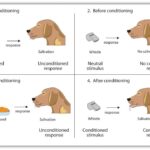Fear, a powerful emotion that grips us all at some point, isn’t innate. Contrary to popular belief, we aren’t born with a pre-programmed set of fears. So, How Is Fear Learned? This article delves into the fascinating science behind acquired fear, exploring the various ways we develop this complex emotion.
Fear Acquisition: Not Born, But Learned
While some reflexive responses like startling at loud noises are present from birth, true fear emerges later. Babies typically display their first signs of fear between 8 and 12 months, often triggered by unfamiliar people or environments. Interestingly, these early fear responses are highly context-dependent. A stranger encountered in a familiar setting, like home with a parent present, is less likely to evoke fear than the same stranger in a strange place. This highlights the crucial role of environment and perceived safety in shaping early fear responses.
Conditioning and Observation: Pathways to Fear
Fear learning primarily occurs through two key mechanisms:
1. Classical Conditioning: This involves associating a neutral stimulus with a frightening experience. For instance, a child bitten by a dog may develop a fear of all dogs, associating the animal (previously neutral) with the pain and fear of the bite. This learned association can trigger a fear response even in the absence of a direct threat.
2. Observational Learning: We also learn fear by observing others’ reactions. Witnessing a friend’s terror at a spider can instill a fear of spiders in the observer, even without personal negative experience. Similarly, hearing about dangers – a parent warning about aggressive dogs, for example – can contribute to learned fears.
 Child hiding behind parent from a dog
Child hiding behind parent from a dog
A child’s fear response can be influenced by observing a parent’s reaction to a perceived threat, like a dog.
The Case of Snakes and Spiders: Are We Predisposed to Fear?
While fears are learned, some, like the fear of snakes and spiders, are remarkably common. This prevalence has led some to propose an innate predisposition to these fears, suggesting an evolutionary basis for quickly recognizing potential threats. However, research indicates that while infants and young children readily detect snakes and spiders visually, they don’t exhibit inherent fear. Young children often show curiosity rather than fear when encountering these creatures.
The widespread fear of snakes and spiders might stem from their frequent portrayal as dangerous or evil in cultural narratives, from ancient mythology to modern media. This constant negative association could contribute to the prevalence of these fears.
Parental Influence and Developmental Stages of Fear
A child’s fears often mirror their parents’ anxieties, highlighting the significant impact of observational learning. Children absorb information from their environment, including their parents’ reactions to perceived threats.
Furthermore, common fears evolve with a child’s cognitive development:
- Infancy/Toddlerhood: Fear of strangers, new places, objects.
- Early Childhood: Fear of animals.
- Middle Childhood: Fear of blood, injury.
- Adolescence: Fear of social rejection.
Individual Differences in Fear Responses
Children differ in their inherent tendency towards fearfulness. Some possess a temperamental predisposition to react more strongly to novelty and perceived threats, making them more susceptible to developing anxieties. These children might benefit from a supportive environment that acknowledges their sensitivity and provides positive reinforcement in challenging situations.
The Complex Interplay of Body and Mind in Fear
Fear isn’t a simple on/off switch. It’s a complex interplay between physiological responses and cognitive interpretation. Our bodies react to potential threats with increased heart rate and other physical changes. However, how we interpret these sensations depends on context and past experiences. A racing heart on a roller coaster might be exhilarating, while the same sensation in a dark alley could trigger intense fear.
Ultimately, fear is a learned response shaped by experience, observation, and individual differences. Understanding how fear is acquired empowers us to address and manage our own anxieties and to foster resilience in children.
